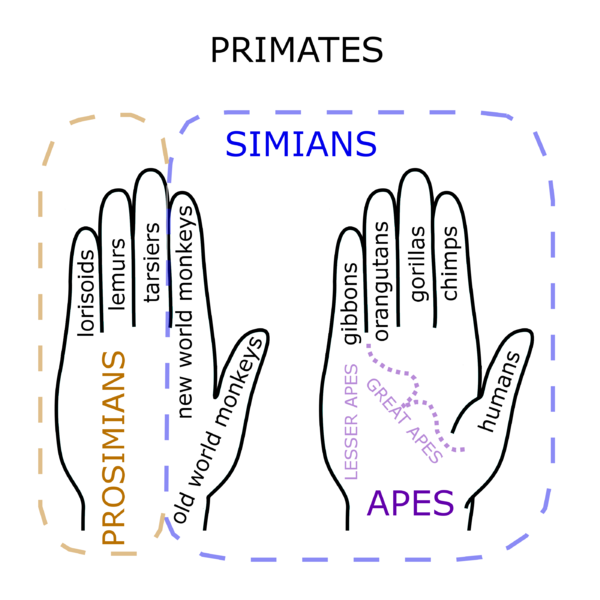File:Primate Hand Mnemonic.png

Original file (2,800 × 2,800 pixels, file size: 403 KB, MIME type: image/png)
Captions
Captions
Summary edit
| DescriptionPrimate Hand Mnemonic.png |
English: This image is a hand mnemonic used to help students learn a categorization of primates. The right hand (held palm upward) correlates to the apes, including the great apes and lesser apes. Humans are distinct from that group as the thumb is distinct from the other four digits of the hand. All apes evolved to be tailless, whereas species grouped onto the left hand are characterized as having tails (with certain exceptions, such as the Barbary macaque). Old world monkeys have a family name that means "tailed ape" and are indicated on the left thumb that points toward the right hand of apes. Old world monkeys are grouped with all of the apes in the parvorder called Catarrhini. New world monkeys on the left index finger form their own parvorder called Platyrrhini (meaning "flat nosed"). These are the only monkeys with prehensile tails. The group of simians (higher primates) are all apes and monkeys, so includes all of the above (Catarrhini and Platyrrhini). The three remaining digits on the left hand form the group of prosimians (lower primates).
The hand phalanges are not to be mistaken for a phylogeny as the branching geometry is not accurate. And the ten hand digits do not correspond to any single particular level of taxonomy. The specific correspondence of digits is:
|
| Date | |
| Source | Own work |
| Author | Tdadamemd |
| Other versions | Derivative works of this file: Primate Hand Mnemonic-ar.png |
Licensing edit
- You are free:
- to share – to copy, distribute and transmit the work
- to remix – to adapt the work
- Under the following conditions:
- attribution – You must give appropriate credit, provide a link to the license, and indicate if changes were made. You may do so in any reasonable manner, but not in any way that suggests the licensor endorses you or your use.
- share alike – If you remix, transform, or build upon the material, you must distribute your contributions under the same or compatible license as the original.
File history
Click on a date/time to view the file as it appeared at that time.
| Date/Time | Thumbnail | Dimensions | User | Comment | |
|---|---|---|---|---|---|
| current | 08:03, 7 January 2013 |  | 2,800 × 2,800 (403 KB) | Tdadamemd (talk | contribs) | User created page with UploadWizard |
You cannot overwrite this file.
File usage on Commons
The following page uses this file:
Metadata
This file contains additional information such as Exif metadata which may have been added by the digital camera, scanner, or software program used to create or digitize it. If the file has been modified from its original state, some details such as the timestamp may not fully reflect those of the original file. The timestamp is only as accurate as the clock in the camera, and it may be completely wrong.
| Horizontal resolution | 28.35 dpc |
|---|---|
| Vertical resolution | 28.35 dpc |
| File change date and time | 04:59, 7 January 2013 |